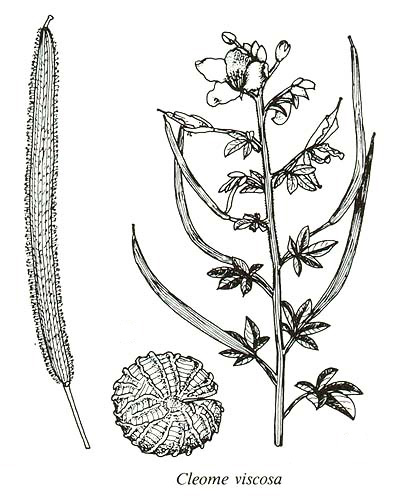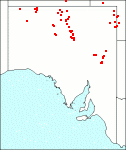Family: Cleomaceae
Cleome viscosa
Citation:
L., Sp. Pl. 672 (1753).
Synonymy: Polanisia viscosa (L.)DC. var. grandiflora Benth., Fl. Aust. 1:91 (1863).
Common name: Tickweed.
Description:
Annual herbs with few erect branches each faintly ridged and with glandular hairs of varying sizes; leaves petiolate, with 3-5 leaflets more or less glandular-pubescent; petiole 0.7-3.5 cm long; leaflets oblanceolate, rarely obovate or elliptic, acute to rounded.
Inflorescence a raceme with leaf-like bracts usually trifoliolate and sessile; sepals 3-8 mm long, glandular-pubescent, deciduous; petals 8-16 mm long, more or less equal b ut often irregularly arranged, attenuate to clawed, yellow, glabrous, deciduous; stamens free, 10 or more; ovary elongate, sessile or almost so, glandular-pubescent, with the short style topped with a broad flat stigma.
Fruit linear-oblong, 3-8 cm long, 3-4 mm broad, with raised veins forming vertical ridges on the valves; seeds almost spherical, with the free ends touching one anther and slightly compressed laterally, rugose with more or less well developed transverse ridges from the centre, dark-brown to black.

| Cleome viscosa
|
Image source: fig 206b in Jessop J.P. & Toelken H.R. (Ed.) 1986. Flora of South Australia (4th edn).
|
Published illustration:
Cunningham et al. (1982) Plants of western New South Wales, p. 338.
|
|
Distribution:
|
Usually associated with river beds, creeks or waterholes.
W.Aust.; N.T.; Qld; N.S.W. Widespread from tropical Africa through southern Asia into northern and central Australia.
|
Conservation status:
native
Flowering time: probably in all months.
|

SA Distribution Map based
on current data relating to
specimens held in the
State Herbarium of South Australia
|
Biology:
A very variable species being densely viscid-pubescent in the NW region and much less glandular to almost glabrescent in the eastern parts of S.Aust. The seed sculpturing also seems to vary greatly depending on the state of maturity as well as from one population to another.
Author:
Not yet available
|

